Adam Equipment S3X-H User Manual

S3X-H Near-/Midfield Monitor
Operation manual / Bedienungsanleitung
English / deutsch

Safety Instructions
Please read the following safety instructions before setting up your system. Keep the instructions for subsequent reference. Please heed the warnings and follow the instructions.
Caution
Risk of electrical shock
Do not open
Risque de shock electrique
Ne pas ouvrier
CAUTION: TO REDUCE THE RISK OF FIRE OR ELECTRIC SHOCK,
DO NOT REMOVE BACK COVER OR ANY OTHER PART.
NO USER-SERVICABLE PARTS INSIDE.
DO NOT EXPOSE THIS EQUIPMENT TO RAIN OR MOISTURE.
REFER SERVICING TO QUALIFIED PERSONNEL.
Caution: To reduce the risk of electric shock, do not open the loudspeaker. There are no user-serviceable parts inside. Refer servicing to qualified service personnel.
This product, as well as all attached extension cords, must be terminated with an earth ground three-conductor AC mains power cord like the one supplied with the product. To prevent shock hazard, all three components must always be used.
Never replace any fuse with a value or type other than those specified. Never bypass any fuse.
Always switch off your entire system before connecting or disconnecting any cables, or when cleaning any components.
Do not place this unit on an ustable cart, stand or tripod, bracket or table. The unit may fall, causing serious injury and/or serious damage. When cart is used, use caution when moving the cart/apparatus combination.
Do not expose this product to rain or moisture, never wet the inside with any liquid and never pour or spill liquids directly onto this unit. Please do not ut any objects filled with liquids (e.g. vases, etc.) onto the speaker.
Check if the specified voltage matches the voltage of the power supply you use. If this is not the case do not connect the loudspeakers to a power source! Please contact your local dealer or national distributor.
2
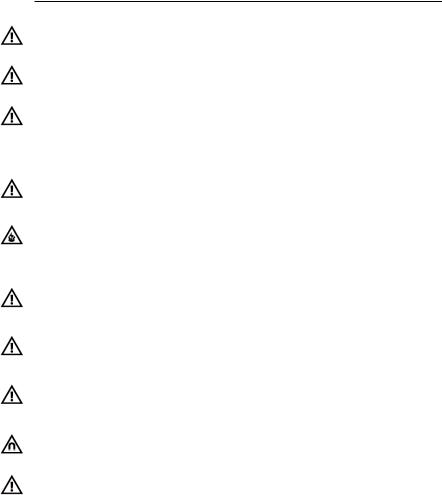
Safety Instructions
Protect the cord from being walked on or pinched.
Always use fully checked cables. Defective cables can harm your speakers. They are a common source for any kind of noise, hum, crackling etc.
Always keep electrical equipment out of the reach of children.
 Always unplug sensitive electronic equipment during lightning storms.
Always unplug sensitive electronic equipment during lightning storms.
The monitor should be installed near the socket outlet and disconnection of the device should be easily accessible.
To completely disconnect from AC mains, disonnect the power supply from the AC receptacle. Never use flammable or combustible chemicals for cleaning audio components.
Avoid touching the speaker membranes and do not block the woofer’s ventilation ports.
Never expose this product to extremely high or low temperatures. Never operate this product in an explosive atmosphere.
High SPL’s may damage your hearing! Please do not get close to the loudspeakers when using them at high volumes.
Please note that the diaphragms build up a magnetic field. Do not ply with magnetic items at close range to the diaphragms.
Assure free airflow behind the speakers to maintain sufficient cooling.
English
3

Table of contents
|
Safety Instructions....................... |
2-3 |
1. |
Introduction.................................. |
5 |
2. |
Set up & Quick Start..................... |
6 |
2.1 |
Important Information for Set Up... |
6 |
2.2 |
Quick Start..................................... |
6 |
3. |
Speaker Placement...................... |
7-8 |
3.1 |
General Recommendations............ |
7 |
3.2 |
Tweeter Height............................... |
7 |
3.3 |
Stereo Setup................................... |
8 |
3.4 |
Surround Setup.............................. |
8 |
4.Controls/Speaker Adjustement..9-10
4.1 |
The front (control) panel................. |
9 |
4.2 |
Standby Switch & LEDs.................. |
9 |
4.3 |
Input Controls................................. |
10 |
4.4 |
Bass Controls................................. |
10 |
4.5 |
Tweeter Controls............................ |
10 |
5. |
Troubleshooting............................ |
11 |
5.1 |
No or distorted Signal..................... |
11 |
5.2 |
Parasitic Noises.............................. |
11 |
6. |
Maintenance.................................. |
12 |
7. |
Transportation / Package............ |
12 |
8. |
Environmental Information......... |
12 |
9. |
EU Declaration of Conformity..... |
13 |
10. |
Limited Warranty.......................... |
14 |
10.1 |
Terms and Conditions..................... |
14 |
10.2 |
How to claim................................... |
14 |
11. |
Technical Data............................... |
15 |
4

1. Introduction
Dear customer,
Congratulations on choosing an ADAM Audio S3X-H monitor!
ADAM loudspeakers are built for maximum audio perfection. With the S3X-H you have selected a precise, high resolution speaker system that allows you to professionally evaluate audio recordings. This monitor meets highest expectations in sound quality and craftmansship.
This manual is intended to provide you with information about your new ADAM. It contains important information regarding safety, setting up, handling, and warranty. We request that you read these sections carefully to ensure an easy set up and to prevent potential problems.
S3X-H
The S3X-H is suitable for both nearand midfield monitoring. It is an ideal tool for situations where a combination of no-compromise sound reproduction and a small footprint is required.
The S3X-H is a three-way ported active system that uses the new X-ART tweeter, ensuring full compatibility with the latest expanded high frequency resolution media formats, and three HexaCone©-bass/midrange drivers. Each one of the three cone drivers uses an individual PWM amp with continuous output of up to 250 Watts (RMS). The tweeter is powered by
a new A/B amp that has been designed by ADAM Audio to realize the tweeters unique abilities without any limitations.
Questions? Problems?
If you have any questions about this or any of our products, please don’t hesitate to contact us–we will be happy to assist you in any possible way.
For detailed information concerning the ADAM technologies and products, complete reviews, and a list of worldwide ADAM users and studios, please visit our website: www.adam-audio.com
We hope very much that you really enjoy your new loudspeakers, and wish you many delightful hours with them.
The ADAM Audio Team
English
5

2.Information For Set Up / Quick Start
2.1Important information for set up
Acclimation: After having unpacked your loudspeaker, please allow the system to acclimate to the temperature of the room. Please do not connect the speaker for approximately an hour.
HQ Cabling: We recommend using high quality cables to guarantee optimal performance.
Solid stand: It is important to ensure the speakers stand firmly on a solid ground!
Package: We recommend not to damage the package and to retain it. The original packaging is the best guarantee for safe transportation (see 7.).
Break-in time: Please note that the loudspeakers will need a few days to achieve optimum sonic performance.
2.2Quick start S3X-H
Before connecting the loudspeakers to your audio components and the power source make sure that both the loudspeakers and your audio system is switched off!
a.Set all level controls fully counterclockwise.
b.Connect the loudspeakers with your audio units: Use a XLR cable. The male plug goes into the loudspeaker, the female plug into your audio component.
c.Check if the specified voltage matches the voltage of the power supply you use. If this is not the case do not connect the loudspeakers to a power source! Please contact your local dealer or national distributor.
If the voltages match, connect the loudspeaker via the included power cables to two AC sockets.
d.Switch on your audio system. Switch on the main on/off switches on the back panel and finally the standby-switch on the front panel of the loudspeakers.
Turn on your source of music and adjust the volume carefully.
6
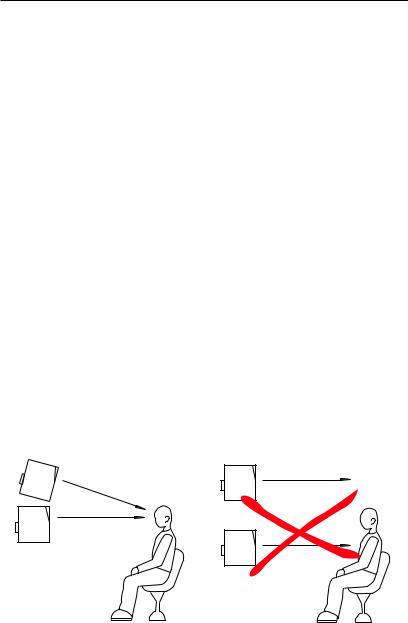
3.Speaker Placement
3.1General recommendations/advises
Direct sound ways: There should be no obstacles in the way from the monitor to your ears. You should be able to see the speakers completely.
Distance to walls: The distance to the surrounding walls should be at least 40 cm to avoid early reflections, which will degrade the sound.
Alignement: The loudspeakers should be aligned with the listener’s position.
Nearby objects: Please note that vibrating parts of nearby objects can mask the sound.
Mechanical adjustements: If you plan to modify the speaker cabinet (e.g. drilling holes), please contact us before doing so. Usually, we will handle your warranty obliging.
3.2Tweeter at the height of ears
The Tweeter should be positioned approximately at the height of your ears. In case you need to position the speaker in a significant lower or higher position, the monitor should be angled accordingly.
Figure 1: Tweeter at height of ears / speaker angling
English
7
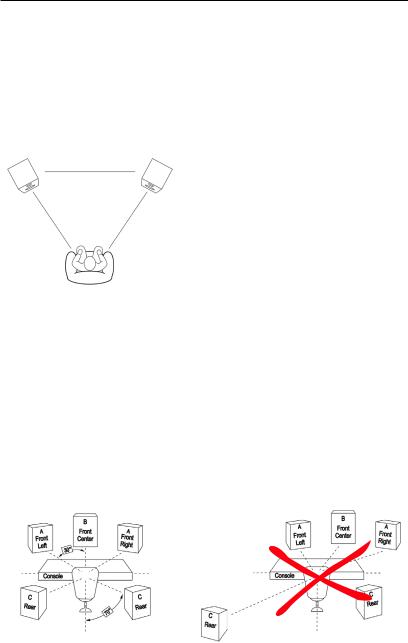
3. Speaker Placement
3.3Stereo set up
If the loudspeaker is going to be used for stereo applications, the optimum listening position should be located in the middle of a stereo triangle. This means that your listening position will be located at the top of an imaginary equilateral triangle and the two loudspeakers should be placed at the other two points of this triangle.
Figure 2: Stereo Triangle
• both loudspeaker and the listening spot should be a equilateral triangle
• approx. the same distances between loudspeakers and the loudspeakers / the listening spot
• alignment towards listening spot
3.4Surround set up
Speaker positioning for multi-channel stereo purposes is ideally based on a circle with speakers placed at 0° (Center), 30° (Front Right), 110° (Rear Right), 250° (Rear Left), 330° (Front Left), with the listener being the circle’s center (Radius between 0.7-2.0 m). This ITU recommended configuration may vary depending on the purpose of the control room (music or film). However, it is recommended to create a symmetrical listening position with the front side and surround speaker pointing to the listener’s ear.
Figure 3: Surround set up
8
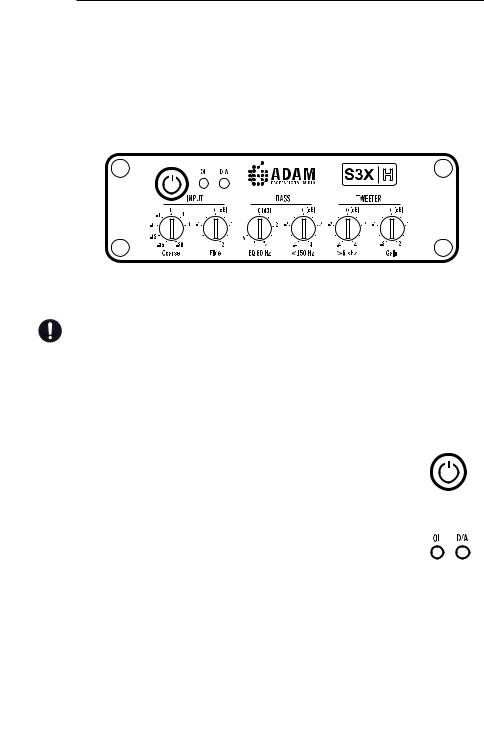
4. Controlpanel/Speaker Adjustment
4.1The front (control) panel
On the front you will find a new, highly sophisticated control panel that allows detailed fine-tuning of your loudspeakers to your particular room acoustics and personal listening preferences. The following tips are intended to assist you at using the controls in the best manner.
Figure 4: Control panel
Please note that using the controls may have a great impact on the overall sound characteristics of your loudspeakers. We recommend using the controls with utmost care and only after several audio tests with familiar recordings.
4.2Standby Switch & LEDs
The main power switch can be found on the rear of the loudspeaker. On the front, there is switch for power on/ standby. In standby mode, the switch glows orange, in power on mode it glows green.
To the right of the standby switch you find two LEDs:
•In case of an overload, the OL LED will flash red. A protective curcuit will safe your speaker from damage.
•All SX-models from the S2X can be retrofitted with a 24 bit / 192 kHz D/A Converter. The D/A LED glows blue when a converter is inserted in the input on the rear side of the speaker.
English
9
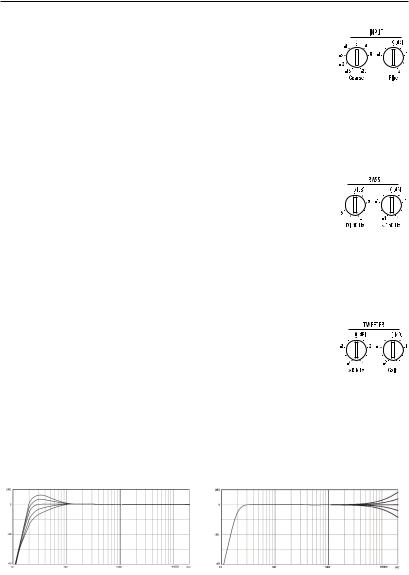
4. Controlpanel/Speaker Adjustment
4.3 Input Controls
There are two different controls to regulate the overall input sensitivity:
•One control allows for coarse settings from -20dB to +8dB. The control works with 4dB steps.
•The other control is intended for fine tuning in 0.5dB steps, ranging from -1.5dB to 2dB.
4.4 Bass Controls
There are also two different controls to regulate the lower frequencies:
•The EQ 80 Hz control is an equalizer to boost bass response.
•The <150 Hz control is a shelf filter that allows to progressively raise or lower the frequencies below 150 Hz (see Fig. 5).
4.5 Tweeter Controls
There are also two different controls to regulate the lower frequencies:
•The Gain control alters the input sensitivity within ±2dB
(0.5dB steps).
•The >6 kHz control is a shelf filter that allows to progressively raise or lower the frequencies above 6 kHz (see Fig. 6).
Figure 5
ROOM EQ <150 Hz for the low frequencies below 150 Hz
Figure 6
ROOM EQ >6 kHz for the high frequencies above 6 kHz
10
